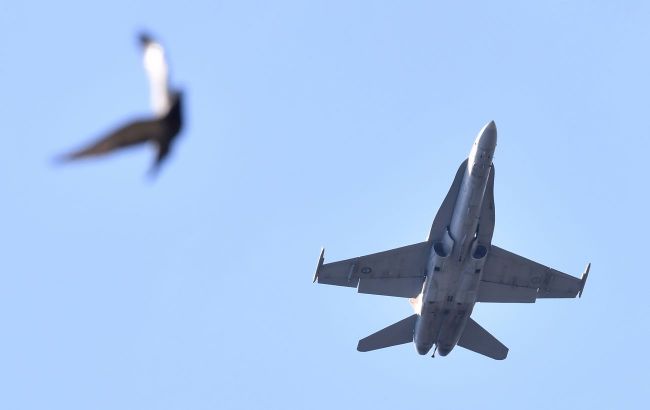F-18 Hornet for Ukraine: expert on pros and cons
 The second type of combat aircraft for Ukraine could be the F/A-18 Hornet (Getty Images)
The second type of combat aircraft for Ukraine could be the F/A-18 Hornet (Getty Images)
Ukraine assumes that after receiving the F-16, there will be discussions about a second type of combat aircraft for the Air Force. It is possible that it will be the multi-role F-18 Hornet. Aviation expert Valerii Romanenko, a leading research associate at the National Aviation University (NAU), provided insights into the pros and cons of the F/A-18 Hornet compared to the F-16 in an interview with RBC-Ukraine.
To obtain F/A-18 Hornets, Ukraine would need to consider the ones retired from the Royal Australian Air Force. Canada has already purchased a portion of them, and the remaining aircraft could potentially be bought by Ukraine.
When comparing the pros and cons of the Hornet to the F-16, the F/A-18 is superior to the European F-16s available to Ukraine. The F/A-18 features more advanced equipment, such as phased-array radar antennas rather than conventional mechanical ones. They are more powerful, capable of detecting targets at longer ranges, and more resistant to radio interference.
The F/A-18 is a carrier-based aircraft with a much stronger structure. It has a more robust landing gear and can currently operate from Ukrainian airfields without significant modifications to runways and taxiways. It is less susceptible to damage and vibrations during landing.
The F/A-18 has two engines and higher air intakes compared to the F-16, reducing the likelihood of foreign object ingestion during takeoff, which can cause engine failure. In the case of the F-16, such a scenario would, at best, result in an emergency landing and, at worst, engine failure leading to the loss of the aircraft.
Therefore, the F/A-18 is more survivable. For instance, over 30 years of service, Australia, having 70 Hornets total, lost only four aircraft, despite expecting a minimum of ten losses.
Another advantage is the low cost. When the Royal Canadian Air Force purchased 25 Hornets from Australia, they paid $90 million, which amounts to less than $4 million per unit, which is quite a reasonable price. In comparison, the minimum price for European F-16s is expected to be no less than $15 million per unit.
There is a tendency for Australia to potentially provide these aircraft to Ukraine for free, along with spare engines and parts. Additionally, there is an ample supply of F/A-18s available. Apart from Australia, Finland, Canada, and Spain will also retire them. This means there are multiple sources to acquire these aircraft.
However, there are several drawbacks to consider. Specifically, the F/A-18 Hornet has not been produced for many years. The US discontinued production in 1988, and Australia in 1990. Australian Hornets were built between 1985 and 1990, making them older than our MiG-29s and Su-27s. It is likely that a significant portion of these aircraft will be used for spare parts. Canada's acquisition of 25 Hornets was primarily to dismantle them (use them for the airframe, landing gear, hydraulics, etc.).
Australian Hornets underwent upgrades in several stages, but not on a squadron level; rather, upgrades were performed by different companies based on the production series. Consequently, they have different defensive systems and information exchange capabilities, including differences in onboard computers.
As a result, the Royal Australian Air Force was unable to form a squadron with aircraft of the same configuration. If Ukraine were to receive these aircraft, the same problems would arise. It would be necessary to collaborate with several companies that performed the Hornet upgrades to obtain technical documentation for servicing the systems. This is an often overlooked but crucial aspect. Alternatively, immediate standardization would require payment to Boeing, which is costly. Modern electronics can be more expensive than the aircraft themselves.
Regarding service life, Australian Hornets have an average flight time of 4,200 hours, with a warranty period of 6,000 hours. Thus, we would receive aircraft with approximately 30% of their service life remaining. The lifespan can be extended, but it would require transporting the aircraft to a maintenance facility. The nearest option is Spain, or through Poland and the Baltic countries to Finland, although it is quite inconvenient.
Another inconvenience is the need to establish a new infrastructure for the F/A-18. If we adopt both types of aircraft, separate infrastructures would be required to support the F/A-18 and F-16, despite the fact that both aircraft have essentially the same purpose and similar armament. The equipment differs slightly, mainly due to different manufacturers. However, dividing the infrastructure is unavoidable, necessitating two separate facilities. The question is whether we can afford it and whether we have a sufficient number of personnel proficient in English to quickly service the aircraft.
Two separate infrastructures make sense if we were acquiring one lightweight fighter and another for air superiority. However, we would likely gain a numerical advantage. For example, Australia could provide one squadron of F/A-18s, and the Netherlands could provide one squadron of F-16s. Belgium would provide a second squadron of F-16s, and we could form another squadron using the Australian F-16s. Since around 40 units are available, we can certainly assemble two operational squadrons.
Regarding F-16 repairs, which cannot be performed independently, we can quickly transport them to Poland. Poland has a mid-level aviation repair facility as they operate these aircraft. Alternatively, we could consider Romania, and within a year or two, Slovakia and Bulgaria will also have F-16s. Therefore, we would have a single type of fighter aircraft shared with most of our Western neighbors.
As for the F/A-18, as mentioned before, the nearest options are Spain and Finland. Another possibility is Canada, which is quite far, but the advantage is that these aircraft can be transported without disassembly, as the wings fold like those of an aircraft carrier-based fighter jet.
Acquiring both types of aircraft is reasonable if the timeline is short, and the quantity exceeds one hundred. It is likely that over 100 F/A-18s and more than 120 F-16s are stored at American bases, but the US is reluctant to provide them at the moment. Once we acquire one of the types, we can persistently request Washington to strengthen us with more aircraft of the same type.
The decision needs to be made at the level of our Air Force. If we have sufficient specialists and resources for two infrastructures, we should acquire both types. Since both are American aircraft, necessary spare parts can always be sourced from equipment manufacturers. If, for instance, we were considering F-16s alongside European Eurofighters, it would not be objectively feasible to have both types in such a combination.
F/A-18 Hornet is 15-20% more expensive to operate than the F-16. The latter is older, requiring more spare parts. Additionally, according to expert estimates, the cost per flight hour for an older F-16 would be nearly twice that of a new one. Yet, we plan to use them intensively.

